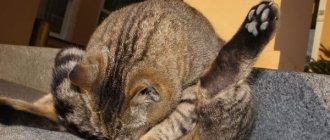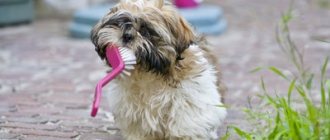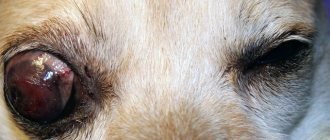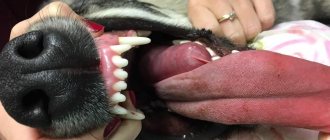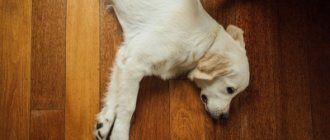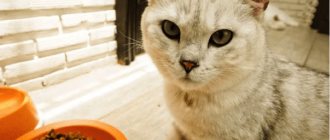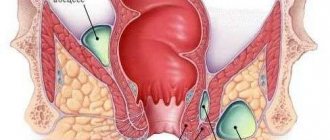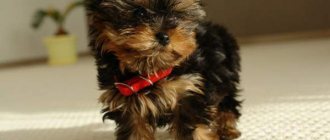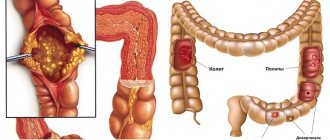Pets need constant care and attention.
Every owner knows that animals need to regularly clean their ears and teeth, trim their nails, and wash their eyes. At the same time, insufficient attention is paid to other, no less important organs.
It is worth knowing that the paraanal glands in dogs also require care. If they are not monitored, an inflammatory process begins that can lead to serious complications.
Symptoms of inflammation
If the secretion accumulates for a long time and does not come out, blockage and inflammation occurs. The pet is experiencing discomfort.
You can tell that a blockage has occurred based on the following symptoms:
- the dog rides on the floor on its butt - in this way it tries to squeeze out the contents of the bags and get rid of unpleasant sensations;
- gnaws, licks the area under the tail, can even gnaw out the fur;
- jumps up sharply and begins to dodge;
- swelling, redness in the anus;
- difficult passage of feces or their complete absence;
- An uncharacteristic odor appears from the anus.
Causes of tumors under the tail in dogs
The most common type of adenoma is perianal adenoma in dogs. With this disease, a tumor the size of a chicken egg grows under the tail. A dog with such a neoplasm must be examined, since the further course of the disease can lead to necrosis and the formation of ulcers.
INTERESTING! Perianal adenoma is more common in males; this pathology rarely develops in females.
Bulldogs, cocker spaniels and beagles are most susceptible to this disease. Perianal adenomas develop due to excess testosterone, which is actively produced in uncastrated male dogs.
A tumor at the base of a dog's tail can develop for other reasons:
- papillomas;
- bruises or injuries followed by the formation of hematomas or abscesses;
- oncology;
- lipoma and other benign neoplasms;
- insect bites.
The tumor may be harmless to your pet, but some varieties are malignant, in which case it is necessary to begin treatment as soon as possible.
Causes of inflammation
The following reasons for such changes are identified:
Rare, irregular walks. The pet is forced to restrain the process of defecation.- Insufficiently active lifestyle.
- Poor nutrition, such as eating too much protein or eating bones.
- Parasites.
- Frequent diarrhea.
- Damage to the anus.
- Genetic predisposition.
Treatment methods for inflammation
If symptoms of a blockage appear, the owner should clean the affected area. You can perform these steps at home. The main thing is to make sure that the problem lies in clogged bags.
For this purpose, the glands are palpated:
- Gloves are put on.
- The index finger is inserted into the anus.
- The area near the exit is carefully examined.
If the sacs are soft, there is no need to clean the glands. Seals indicate the need for the procedure.
Cleaning at home
To perform cleaning you will need:
- gloves made of rubber;
- cloth or napkin;
- petrolatum;
- pelvis
The procedure is unpleasant and will not bring any pleasure to the pet. It's worth calling someone for help. The second person will hold the dog in the correct position, preventing it from escaping. He will need to talk to the animal, calm it down and praise it.
There are two ways to clean the affected area. The first of them involves performing the following actions:
- The animal is placed in a basin.
The assistant holds the dog's muzzle and body so that it does not spin.- Put on gloves.
- Feel the seal from the outside.
- Raise the tail as high as possible to relax the sphincter.
- The anus is lubricated with Vaseline.
- With your free hand, squeeze the sides of the anus.
When the procedure is performed correctly, the bags release a beige liquid with an unpleasant odor. In its absence, increasing pressure is strictly prohibited. Perhaps the blockage is so severe that it will not be possible to clear the passage on your own.
The second method is used for large dogs. Cleaning is carried out according to the following instructions:
- The pet is placed in a bathtub or basin.
- The assistant is holding the dog.
- Gloves are put on your hands.
- The index finger of the right hand is smeared with Vaseline.
- The tail is raised with the left hand.
- A lubricated finger is carefully and slowly inserted into the anus. The palm should be placed perpendicular to the floor.
- The gland can be felt from the inside.
- The secretion is squeezed out by simultaneously pressing with the index finger from the inside and the thumb from the outside.
- After cleaning, the pet is washed, eliminating the unpleasant odor.
How often should you clean
As a rule, cleaning is carried out once every six months.
The interval between procedures largely depends on the speed of blockage and the individual characteristics of the pet. Sometimes the veterinarian prescribes more frequent procedures.
Rectal prolapse
Rectal prolapse is diagnosed when the outermost part of the colon protrudes from the anus. This disease can develop after a dog has suffered from severe diarrhea or constipation for a long time. The animal will feel constant pressure in the anus, so it will instinctively try to straighten the protruding intestine. But it is impossible to help a pet with such a serious problem on your own. You should definitely contact a veterinarian who:
- will straighten the intestine and suture the sphincter muscles to prevent relapse;
- select a wet diet or medications to soften the stool (this will help reduce tension);
- will perform an operation to excise the lower part of the intestine if a relapse does occur.
If it is clearly visible that a lump has appeared under the dog’s tail or the skin near the anus itself is swollen, the use of any traditional methods of treatment is strictly prohibited. There is a small chance that cancer has developed.
The use of medications to treat inflammation
Sometimes cleaning is not enough to fix the problem. Drug treatment is prescribed. Treatment tactics largely depend on the degree of neglect of the situation and the condition of the pet.
Antibiotics
When a bacterial infection or severe inflammation occurs, antibiotics are prescribed. Typically, the following are used:
- Cefotaxime. Detrimental to gram-negative and gram-positive microorganisms. Prescribed for the treatment of purulent processes and their prevention.
- Cephalexin. A semi-synthetic antibiotic agent with a bactericidal effect.
The doctor selects the dosage individually. The veterinarian also determines the duration of therapy. Self-medication with antibiotics is strongly discouraged.
Medicines can cause side effects, if they occur, the use of the medicines should be stopped immediately.
Rectal suppositories
For inflammation of the paraanal glands, the veterinarian prescribes the use of a suppository. Rectal suppositories eliminate inflammation and accelerate the healing of affected tissues. The following drugs have the maximum effect:
- Ichthyol suppositories;
- candles with calendula;
- Methyluracil;
- Proctosedyl.
Therapy lasts from 8 to 20 days. Suppositories are used only if the anal glands are not opened. They are administered after each natural bowel movement or enema. Therapeutic suppositories are inserted into the anus with clean hands, then the dog’s tail is pressed for several minutes.
Inflammation of the paraanal glands in dogs. Causes of blockage
In nature, everything that is not used degrades. In modern dogs, the glands can no longer function at the same level as in their wild relatives, which is why fluid stagnation occurs, causing a chain reaction
further development of the pathology.
- Experts call the following factors predisposing to inflammation of the anal glands in dogs:
- sedentary lifestyle;
- excess weight in dogs puts them at risk, so it is advisable for them to clean their glands for preventive purposes;
- the influence of hereditary predisposition - most often the disease occurs in representatives of small and decorative breeds: Pekingese, dachshund, pug, bulldog;
- low immunity - pets have a weaker immune system than their street relatives;
- anal injuries and their infection with pathogenic microflora;
- dietary errors, for example, giving bones and other roughage;
- pregnancy;
- frequent matings;
- a large amount of protein foods;
- insufficient control over the condition of the paraanal glands by the owner.
How does inflammation of the paraanal glands develop in dogs?
The anal glands look like small sacs located in the anus area like the numbers 4 and 8 on a watch dial. They constantly, like all glands, produce their secretion. If they overflow
, then they increase in size, become inflamed, and the outflow of fluid does not occur.
- We can highlight the following stages in the development of inflammation of the paraanal glands
- normal outflow of fluid from the glands does not occur;
- they overflow and swell;
- the secretion in the glands thickens;
- the cavity of the gland becomes inflamed and the animal feels pain and itching in the anal area;
- pathogenic microbes multiply in the inflamed area;
- this leads to worsening inflammation, the development of a purulent process and an abscess;
- if the abscess is not treated surgically, it ruptures on its own, forming a through hole between the gland and other organs;
- the temperature will rise and sepsis will develop.
:
Of course, it will take time before an abscess occurs, and an attentive owner will not let the disease take its course, which could result in the death of the pet. The glands operated on as a result of an abscess often become inflamed and fester again, in which case surgery to remove them may be required.
The role of proper nutrition in treating a pet
It is extremely important when carrying out therapy to correctly formulate the dog’s diet. It consists of easily digestible foods containing fiber. Thanks to dietary fiber, the bags are naturally cleared of secretions and fluid stagnation is prevented.
To avoid causing diarrhea and constipation, your pet should be fed exclusively with high-quality, fresh foods. It is imperative to follow the regime. Overfeeding is unacceptable.
Canned, smoked, salty, fatty and spicy foods are excluded from the menu. It is strictly forbidden to give the dog food from the table. In certain situations, veterinarians recommend enriching the diet with multivitamin supplements, bran, and giving the animal mineral complexes.
Treatment
Therapeutic procedures consist of sanitation of the paraanal glands (mechanical cleaning) and cleaning of the wound, in the presence of a fistula. Next, antibacterial agents and broad-spectrum antibiotics (amoxicillin, cephaloxin) are used with a course of treatment of at least 14 days. Rectal suppositories (ichthyol, proctosedyl) are inserted into the lumen of the rectum.
The main treatment for chronic inflammation is surgical. A sacculectomy is performed followed by therapy with antibacterial drugs.
Surgical intervention has its own nuances. Since excision removes the site of purulent accumulation (abscess), and the glandular tissue is not compact and its parts can remain in the tissues and continue to function, relapses are possible.
When Removal is Required
The operation during which the paraanal glands are removed is called saculectomy . It is used to prevent relapse. Surgical intervention is indicated when cleaning is carried out very often.
Removal of the glands is necessary for an abscess with severe tissue damage. These organs are not vital. Surgery is considered a more humane solution than constant treatment of inflammation.
The indications for surgery are:
- an abscess that appears after complete therapy;
- chronic blockage.
Removing the glands is a simple operation. The doctor makes several small incisions over the sacs. Then they are taken outside and cut off. The rectum appears intact. The dog feels good a day after surgery and is able to empty his bowels on his own.
During the postoperative period, the dog is fed light food. You need to take your pet for walks often.
It is unacceptable for your pet to endure the urge to defecate, otherwise the stitches will stretch and the recovery process will be long.
What it is?
You should know that there are several glands around the anus, the secretion of which does not have a particularly pleasant appearance or smell, but plays an important role in the social behavior of dogs. We are talking about the paraanal sinuses, the contents of which, a liquid with an oily consistency and a brownish-yellow color, give a special “refinement” to the smell of dog excrement and allow animals to carry out “color differentiation.” Not by the pants, of course... Simply put, this secret helps dogs mark their territory and instill fear in their competitors.
So here it is. If for some reason the contents of the sinuses are not passed into the feces, it accumulates in the glands themselves. If after some time the secretion still goes as intended, nothing bad happens, but otherwise it causes severe inflammation and a painful reaction.
Abscess of the paraanal glands
An abscess is compared to a burst balloon. The secretion inside the pouch constantly accumulates without coming out. After some time, a breakthrough occurs in the walls of the glands. Among the characteristic symptoms of such changes:
ulcerations;- redness, swelling in the anus;
- constant leakage of foul-smelling liquid;
- the fur near the anus becomes damp;
- increased body temperature;
- lethargy;
- refusal to drink or eat.
Symptoms
The animal is worried. He often sits down and stands up. The discomfort zone, the anus area, becomes a place of special attention for the quadruped. Licking, biting, riding on the tail, rubbing the tail against objects occurs constantly or regularly. Temporary relief of a clinical condition cannot be considered recovery, since the process without assistance becomes chronic.
The anatomical location of the paraanal glands is swollen, compacted, painful, and hot.
It is difficult to determine the general body temperature, since it is elevated in the sphincter area.
Sometimes the secretion, contaminated with purulent microflora, lyses the tissue and a fistula appears, extending outward or into the lumen of the rectum. The expiration of the contents alleviates the animal's condition, but this condition is temporary.
On palpation, pain is determined, the swollen area is soft and fluctuating.
On the wound surface there may be scabs of dried pus, secretions, and blood. They are joined by wool and dirt.
The smell emanating from the inflamed area is foul.
What to do to prevent inflammation
To prevent blockage and inflammation, you must adhere to the following recommendations:
- systematically sanitize the glands in dogs prone to blockage;
- Make sure your pet has bowel movements regularly;
- walk the dog on a schedule, without making him endure it for a long time;
- wash your pet thoroughly with soap and water twice a month;
- while washing, do a gentle massage of the bags;
- Avoid physical inactivity in the dog; long walks and sufficient physical activity are required;
- carry out regular deworming;
- properly organize your pet's nutrition.
Prevention
The basis of prevention is the implementation of sanitary and zoohygienic standards when keeping animals, as well as compliance with rational feeding of carnivorous animals, the majority of which should consist of food of animal origin.
Regular examination of the animal will allow you to timely detect the problem and provide assistance.
Walking and exercise are also a prerequisite for the proper functioning of the whole body.
If an animal is genetically predisposed to blockage of the excretory ducts, and this phenomenon is observed regularly and often, then sanitation is necessary. As a rule, this procedure is carried out by the dog owner before bathing the pet. To do this, it is enough to thoroughly soap and massage the anus area.
In everyday life, the paraanal glands are called the paraanal sinuses, which are sort of sacs on the sides of the dog’s anus. The ducts of the hepatoid and sebaceous glands flow into each sinus. When the secretions of these glands are mixed, a mucous substance is formed, which serves for marking. In nature, the ancestors of dogs sprayed this secretion to mark their territories. Each sac can contain up to 0.5 ml of mucous secretion.
Normally, a dog empties its anal sinuses during defecation. Then you can notice a small amount of white liquid on the fresh stool. It happens that the secret thickens. In such cases, blockage of the paraanal glands occurs. A veterinarian or paramedic can clear clogged glands. Some owners cope with this task themselves.
Under unfavorable circumstances, inflammation of the paraanal glands develops, leading to an abscess or even a fistula.
Possible complications
The danger of the inflammatory process lies in the risk of complications.
If measures are not taken in a timely manner, the rectum is affected. Pathologies such as paraproctitis and proctitis develop. The worst consequence is the death of a pet, so it is very important not to ignore the problem that has arisen, but to deal with it in a timely manner.
When is the best time to visit a veterinary clinic?
Veterinarians strongly do not recommend self-medication . Symptoms of inflammation of the anal sacs are in many ways similar to other pathologies. Distinguishing one problem from another on your own is problematic.
Expert opinion
Panteleeva Irina Petrovna
Breeder, 11 years experience.
If your pet's condition worsens and signs of an abscess appear, you should not hesitate to contact a veterinary clinic, otherwise the animal may die.
Saculectomy
This operation to remove the paraanal sinuses is performed in dogs in cases where inflammation and abscesses recur more often than once every 1-2 years. In principle, in healthy dogs the paraanal glands do not become inflamed so often. Therefore, a complete examination is necessary before surgery.
Paraanal sinuses also have to be removed in dogs that require weekly gland emptying.
Saculectomy is performed under general anesthesia. After the operation, daily treatments and wearing protective underwear (pants) are required.
